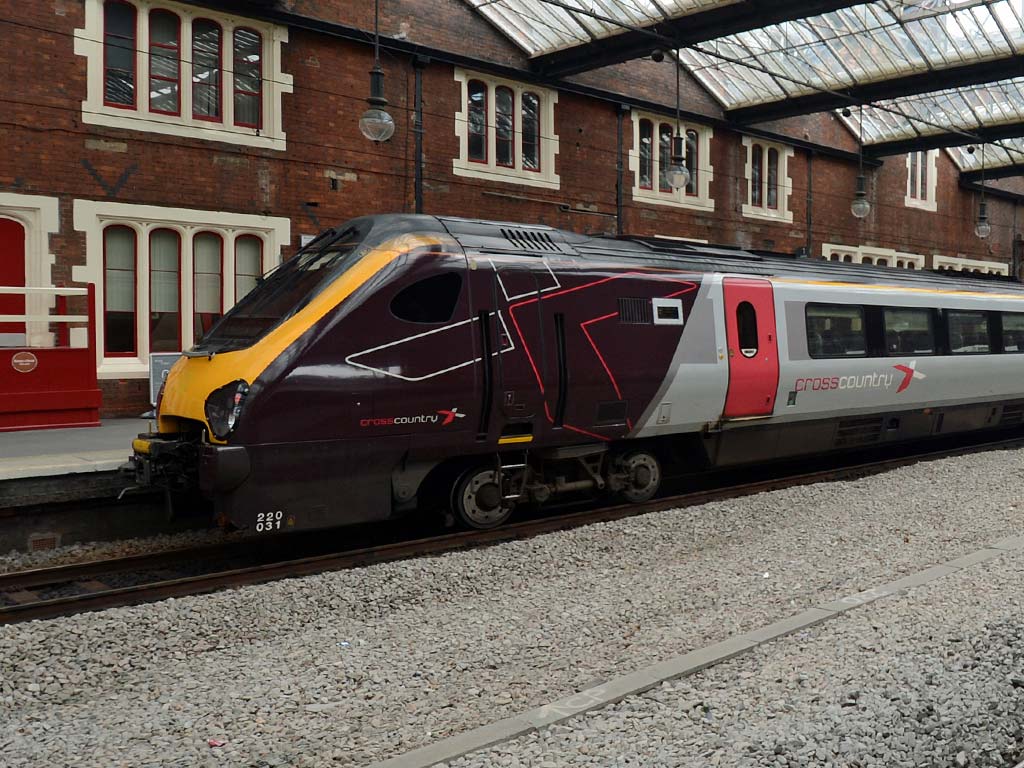samrammstein
Member
It now appears that CrossCountry allocations are being displayed on RTT.
It now appears that CrossCountry allocations are being displayed on RTT.

For the avoidance of the same type of doubt that occurred when you first posted this - the Live Departures site is showing the number of carriages in the train, while RTT is showing the train formation and unit numbers. Neither are showing the actual TOPS number of each carriage (for which "vehicle number" might be the more generally-understood term).Correct. Just carriage numbers I used https://live-departures.info/rail/dppc/manchester-piccadilly etc for. Glad to see RTT now has carriage numbers and other additional facilities.
Not the EMR 153s hired for the Cleethorpes to Barton-on-Humber services yet though. I'm sure it's on the to do list though and I'm not grumbling as it's a brilliant update
Looks like that Tweet about XC not giving out allocations didn't age well.
Jan 2020: #DontTellCrossCountry
Oct 2020: #CrossCountryTellsYou
We're excited to team up with @RealtimeTrains to provide you with real-time unit formations and allocations via https://realtimetrains.co.uk
Know how long your train is, and where to find your seat, before you board!
The timetable data has started massively disagreeing with the specification that comes out for it, it should be EMU331 really rather than E331, so I've added that to the todo list to add for mappingsAnyone noticed the little quirk that Class 331 EMUs seem to come up as " Pathed as Electric locomotive, trailing load 331 tonnes at 100mph "?
Speaking of 331s, some Blackpool North to Hazel Grove are omitted today. Some others are saying 3-car on RTT but not on Journey Check.
There is an issue, as noted in the Limitations bit on the Know Your Train help page, which results in some units not appearing at all. If a service is allocated with these units in formation then the message to tell me this is not generated. This can cause issues where no allocations are shown all day or, if there is service disruption, then incorrect units can be displayed following diagramming changes.The Barton ones are now showing, complete with diagram in EMT colours.

I've thought for some time that PIS displays should be linked in with RTT. It would do away with situations like planned diversions where the PIS can't cope because the amended calling pattern isn't in the on-train system, which of course means the PIS is just switched off (and the train is then technically not PRM compliant).This is all rather good - and I'd hope to see you get some business for providing it for the "new generation" PIS displays...like the likes of DB and SBB have done for 20+ years
The expected behaviour is correct, by default the quick search only searches in the simple mode. Searching on any detailed mode page, or adding detailed to the end of a quick search query, shows 385041 on 5N93.
Why would RTT do this when not even the TOC uses these names anymore, other than the FSHi Tom. Now some TOC’s are providing more details, what would be the chances of ‘named trains’ being identified. The Northern Lights, The Highland Chieftain, etc. Thanks.
Comes down to this: using detailed mode will show you if it's allocated anything today and if it comes up with nothing then it's not allocated. The 0921 Blackpool-York is of course today so appears when searching as it's the next booked work for that train.Thanks Tom. I wasn't suggesting that the behaviour is incorrect, rather that the message is inaccurate. Eg using quick search for 195 118 a couple of minutes ago (at 08.14), shows it's on 09.21 BPL - YRK (1B22), which hasn't departed yet. And so the bullet point that 'It will only search for services that have departed today' doesn't seem to be true. Apologies if I'm misunderstanding something.
Fairly unlikely I think. I wrote in support for it in a version of RTT that was never released back in 2014 but it actually became somewhat of a pain to track the updates to schedules in doing it.Hi Tom. Now some TOC’s are providing more details, what would be the chances of ‘named trains’ being identified. The Northern Lights, The Highland Chieftain, etc. Thanks.
Thing is, I think the message is okay - as it won't appear if there is an allocation against a schedule. If a train is allocated to purely an ECS working, then it won't appear on a simple mode search then perhaps it's a bit misleading but if it's not in service then it's not of much use to anyone bar those trying to tick trains off for sight.... but at that point you'd be using detailed mode anyway?Thanks Tom. I wasn't suggesting that the behaviour is incorrect, rather that the message is inaccurate. Eg using quick search for 195 118 a couple of minutes ago (at 08.14), shows it's on 09.21 BPL - YRK (1B22), which hasn't departed yet. And so the bullet point that 'It will only search for services that have departed today' doesn't seem to be true. Apologies if I'm misunderstanding something.
Thanks Tom. I wasn't suggesting that the behaviour is incorrect, rather that the message is inaccurate. Eg using quick search for 195 118 a couple of minutes ago (at 08.14), shows it's on 09.21 BPL - YRK (1B22), which hasn't departed yet. And so the bullet point that 'It will only search for services that have departed today' doesn't seem to be true. Apologies if I'm misunderstanding something.
Could it be that what you want it to say is "It will only search for services that have departed or are scheduled to depart today"?

Just looks like a circular train problem with the front end not knowing how to interpret data in the API (as an educated guess)?Here is something I see quite often on RTT (and it's usually with test train schedules, which of course are rather different to normal ones.
It's not hard to see what's happened. But in order for RTT to make this interpretation, it has to be OK with the concept that a train can get to a location in the schedule, earlier than it gets to the location before it. If RTT knew this was impossible, it wouldn't make the interpretation below.
I'm curious to know whether there's some kind of programming complexity that means RTT can't "know" about such an impossibility.
View attachment 86045
In this case not a circular route as such - but a reversal en route.Just looks like a circular train problem with the front end not knowing how to interpret data in the API (as an educated guess)?
Yes, but a scheduled reversal, and I do find it odd that the 'system' recognised the train in the return direction at many points where it didn't on the outward leg.In this case not a circular route as such - but a reversal en route.
Those will be the correct times for the passing points in the outward direction, you’ll see the individual times are increasing going UP the list. I’ve seen it happen before when trains go back where they came from without changing IDs.Yes, but a scheduled reversal, and I do find it odd that the 'system' recognised the train in the return direction at many points where it didn't on the outward leg.
Yes, they quite obviously are - the question is why the system assigns them to the timings in the return direction. You'd think it would be trivial to compute that if you pass a point shortly after passing an adjacent point, it's more likely to correspond to the point immediately after that one in the schedule, rather than one later in the schedule which would require skipping a load of points inbetween and travelling at an implausible speed.Those will be the correct times for the passing points in the outward direction, you’ll see the individual times are increasing going UP the list. I’ve seen it happen before when trains go back where they came from without changing IDs.
You'd think it would be trivial, but the matching is done using the "expected time" data which is passed when an event occurs. There are lots of reasons the expected time in the event might not match the published timetable - a variation or short-term plan wasn't sent to the public feed for example, or the data was entered manually and incorrectly. If that's the case you've got to have your systems "guess" which event the update applies to. Here it looks like the rules which make that guess are less smart than your eyeballs, but then computer systems are just dumb rules that do what you tell them to - they can't just glance at the overall data and decide it looks silly. That means when you are coding them that you have to think through (or see) every form of silliness that can appear in the feed and make sure your rule set covers them.Yes, they quite obviously are - the question is why the system assigns them to the timings in the return direction. You'd think it would be trivial to compute that if you pass a point shortly after passing an adjacent point, it's more likely to correspond to the point immediately after that one in the schedule, rather than one later in the schedule which would require skipping a load of points inbetween and travelling at an implausible speed.
